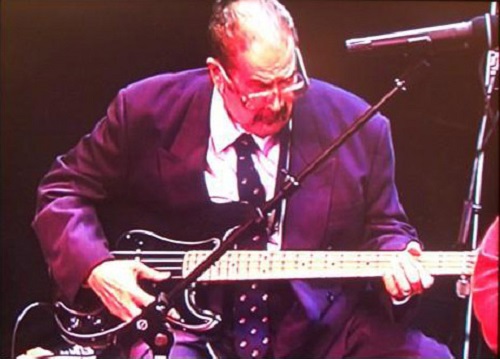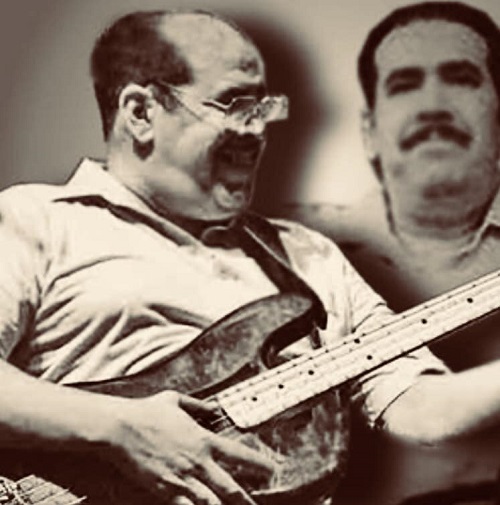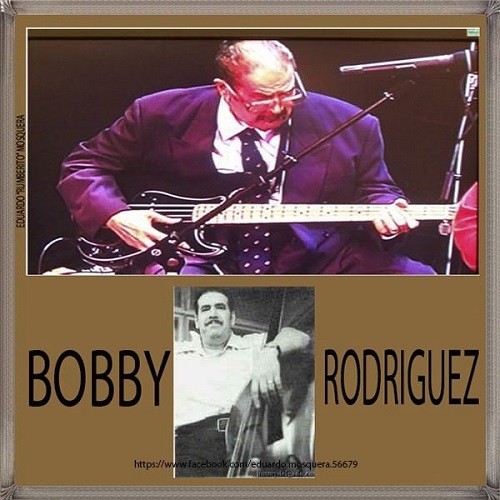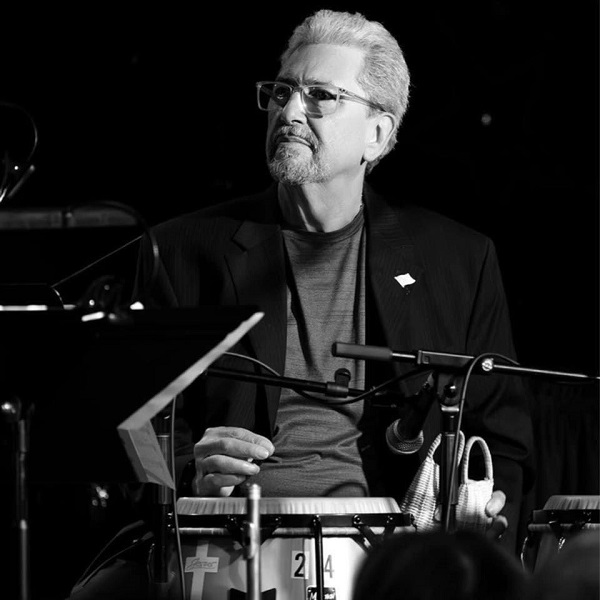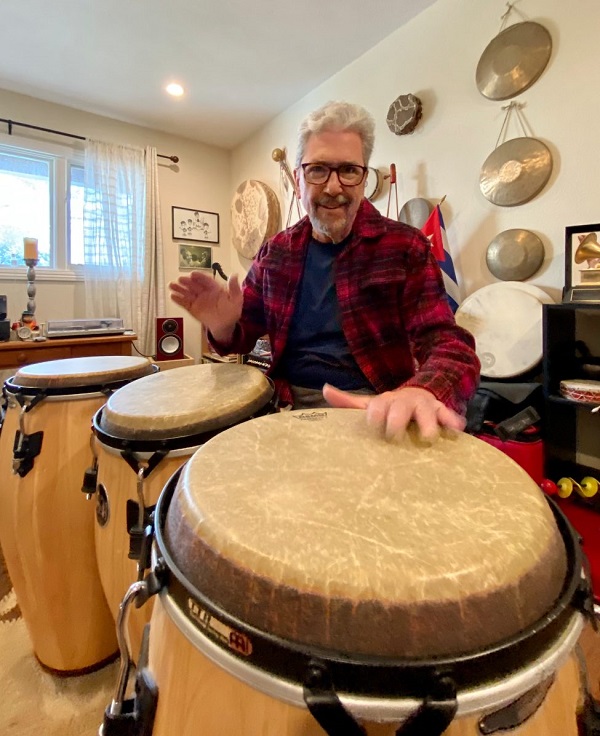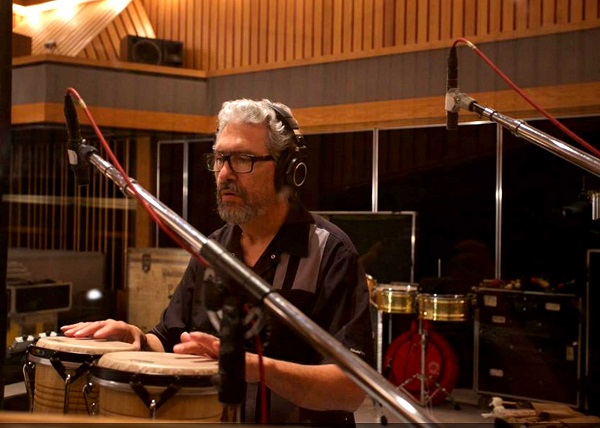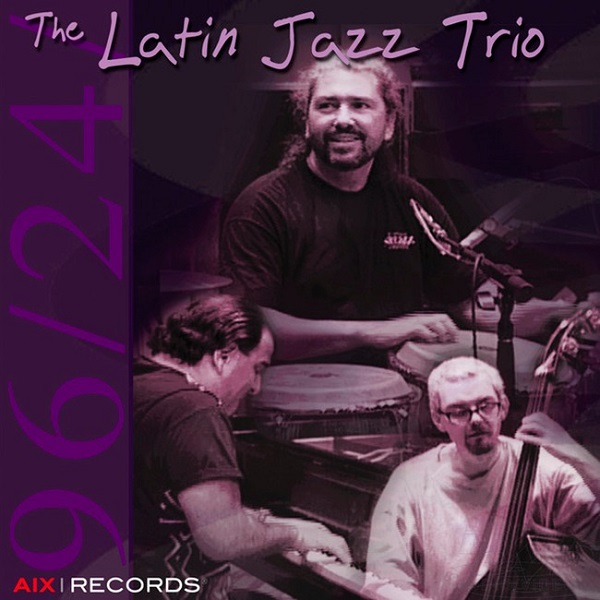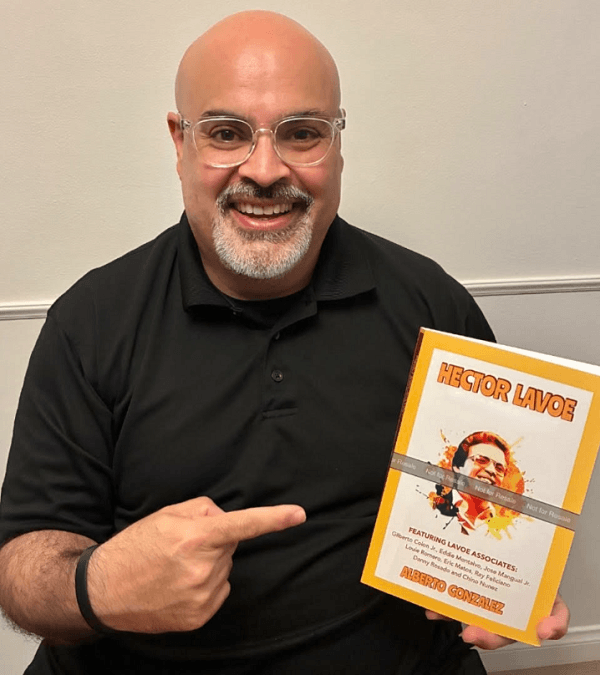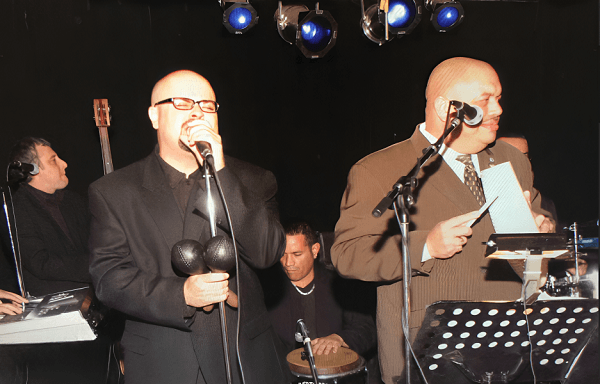By: Professor MSc. Carlos Colmenárez (Barquisimeto, Venezuela)
Hello there, regular Salsa Escrita readers, here is your ever friend, Professor Carlos Colmenárez MSc, greets you from Barquisimeto, the musical city of Venezuela. In this edition, we are introduing three vocalists and an orchestra with a great trajectory at a national and international level, who have done a great job on behalf of Latin music and we want to continue projecting them worldwide on these pages.
Among these names are: Jorge Luis Suárez, Cheo Valenzuela, Gustavo Gerardo and the orchestra “Negramenta”, si I certainly hope the written interaction between you and us is to your liking.

Jorge Luis Suárez, “Pride and Symbol of Afro-Caribbean Music”

In Venezuela, musical talent is without a doubt top of the line and of proven quality nationally and globally. A great number of artists with seniority and status have emerged and born in Barquisimeto, Lara, exalting our Latin rhythms.
For this edition of “Salsa Escrita”, we are honored to have as a special guest the vocalist Jorge Luis Suarez, pride and symbol of Afro-Caribbean music and diverse genres, who has showed his class and professionalism for years.
Jorge Luis is a singer, musician and multi-faceted artist; he was born on August 7 in the city of Maracaibo, the son of parents from the city of Carora, where he spent the most of his childhood in the state of Lara, began to lean towards music, and was largely influenced by his father, who played the guitar and sang romantic music.
At the beginning of the 80’s, he moved to Barquisimeto to attend university and was discovered as a singer and bass, cuatro and guitar player. Welcome to “Salsa Escrita”, through International Salsa Magazine, Jorge Luis Suarez.
To start this pleasant, enjoyable and long-awaited meeting, we would like you tell us your experiences about your artistic career, which has been very successful nationally and globally to make everyone who knows you very proud.
Thank you Professor Carlos Colmenárez for inviting me to your widely read and recognized salsa column, unique at a national and international level and in which you project Venezuelan musicians.
Jorge Luis, with which groups did you start your journey of this wonderful art in which you have demonstrated versatility, perseverance, discipline and quality? Well, let me tell you that I started my musical activity professionally, being part of groups of regional standing like “Las Estrellas del Momento”, “Orquesta Alegría” and then “Venezuela en Gaitas”, “Sason Latino” and at the end of the 80’s and beginning of the 90’s, I joined the staff of the orchestra “La Banda Actual”, a salsa icon in the state of Lara.
By the way, Jorge, we remember your beginnings with “La Banda Actual” and it was an obligatory reference for private parties, night places and of course sharing stage with great artists and Latin and Caribbean music luminaries.
In which groups did you have the joy and the pleasure to sign with national and international stars? In fact, Professor, when I was part of La Banda Actual, we performed with Héctor Lavoe, Wilfrido Vargas, Las Chicas del Can, Porfi Jiménez, Guaco, Los Melódicos, Hermanos Carruyo, Billos Caracas Boys, Orquesta La Crítica and many more during their visits to Barquisimeto, having the Bolivarian Dome and the Trade Fait Complex as locations.
In fact, Jorge Luis, due to your outstanding vocal capacity, gave rise to the call of Luis Frómeta, Billo Frómeta’s son, to join the ranks of Billo’s Caracas Boys. With them I learned to have more artistic discipline and gain experience during 4 years, managing to record three musical productions and traveling through Latin America, the US and Europe; precisely in the Tenerife carnivals we achieved the Güines Record related to public attendance to a dancer, sharing the stage with Celia Cruz and Oscar D’León.
Jorge, tell us about your entry into the orchestra of the world’s leading sonero Oscar D’León. Professor Carlos, precisely as a result of that event in the Canary Islands, Oscar called me and told me that he needed a vocalist of my characteristics to accompany him in his shows and international tours and honestly, it was a difficult decision because with Billo’s Caracas Boys, I was well established along with other Barquisimeto artists: Ely Mendez and Wolfang Perdomo, integrating the line of vocalists for that time, it was all “guaros” (nickname received by the Barquisimeto people).

But I found Oscar’s offer interesting and finally I said yes. With the Word’s Leading Sonero, to whom I owe a lot, because thanks to him I established myself even more as a performer and especially in salsa, bearing in mind his recommendations to the letter and of course it was an unforgettable experience, since with his orchestra we traveled many countries and performed on stages such as: Carnegie Hall, Madison Square Garden, House off Blue in Los Angeles, Orange Ball, jazz festivals in Europe, sharing with established artists.
Professor, while I worked with Oscar’s orchestra, I recorded my production “Una Tercera Persona”, in mid 1992, which spawned the hit single “Niegalo Todo”, obtaining the first places in the hit parade.
In that production, I was accompanied by renowned musicians, such as Luisito Quintero, Roberto Quintero, Robert Vilera, Raúl Agraz, Yorman León and the Nicaraguan Luis Enrique.
Jorge, how many years did you work with Oscar and why did you decide to leave his orchestra? I worked with Oscar for approximately four years and I decided to leave the group due to force majeure such as business and commercial commitments that I had and still maintain to this day in Barquisimeto.
For those who do not know, Jorge Luis is a multifaceted artist and has managed to enter in different musical genres as a vocalist, from salsa, bagpipes, tropical dance, guaracha, merengue, Venezuelan and boleros; becoming the musical arranger and producer of the trio Carora International at the end of 2014 in the last one.
At the same time, he produced and performed 19 Venezuelan music songs with arrangements by Jean Piero González, which will be released soon.
Jorge Luis, when you settled again in the musical capital of Venezuela, who did you record with? Professor, in Barquisimeto I have been invited to record with the following groups: Venezuela Somos Gaita, Nikitao, Amantes de la Gaita, Venezuela en Gaitas, Unión Gaitera, Rafa y sus Diamantes, Grupo Colorama, Con Klase, Orquesta Variación, Orquesta la Mayor, Orquesta la Gran Premiere, Venezuela Rumba, La Orquesta Raza Caribe, recording 8 songs with this last one in the production that is also about to be released.
Likewise, I was invited to record with the Son Colón Orchestra from Maracay and the Latin Grammy nominees, our Grupo Santoral from Barquisimeto, participating with them as a special guest in the show “El Amor se Canta” during Valentine’s Day, touring and starting in Juares Theater and other cities in the country, and private presentations.
Regarding current projects, what can you tell Salsa Escrita readers? Currently, my second solo production in the gender of salsa is about to be released with arrangements by Barquisimeto multi-instrumentalist Taylor Aranguren and myself.
We are releasing the album this June with the promotional track “No lo beses”, a song that was interpreted by Alejandro Fernández and by Mexican composer José Luis Roma. The production is called “Jorge Luis Suarez Covers”, which includes songs that have been hits around the world, such as: Cobarde cobarde, Escándalo, La bomba, Cuatro rosas, Darte un beso, El amor más grande del planeta, Bailando, No lo beses, among others.
In this production, I am accompanied by my nephew Taylor Aranguren and the musicians: Carlos Giménez, Rómulo Paiva, Jeison Marchán, Wílner Navas, Freddy Adrián, in the master and mixes: Latin Récods Digital.
Sound engineer: René Zerpa and in the general production: Jorge Luis Suárez. Jorge Luis, what are your social networks or digital platforms to interact with your followers? My contacts are, Instagram: @jorgeluissuarezoficial, Youtube: Jorge Luis Suárez Oficial, [email protected].
Jorge Luis, finally, we want to congratulate you for your consistency in music and wish you continue to fresh triumphs, because you have quality and to spare. Salsa Escrita “La Columna Salsera”, will be at your disposal to support you in your present and future projects, at a good time… Thank you professor and personal friend, Carlos Colmenárez, for offering me your support in your salsa column, allowing me to reach your regular readers all over the world; once again a thousand thanks, blessings and long live Venezuela!.
Cheo Valenzuela, “El Sonero de la Dulzura”

We are pleased to have as a special guest in our salsa column one of the vocalists who has a unique, admirable and respected quality of interpretation, which has been highlighted in our country and abroad and took his flavor and swing with great professionalism and hierarchy. We are talking about Cheo Valenzuela, “El Sonero de la Dulzura”, born in Cantaura, Anzoátegui on January 24th.
At the age of 7, he moved with his family to the city of Caracas, specifically in one of the most popular parishes: La Pastora. Welcome Cheo to Salsa Escrita, “La Columna Salsera” and International Salsa Magazine. Thank you, my friend and professor Carlos Colmenárez, for giving me the opportunity to be present in this tribune of our Afro-Caribbean music, which serves us to make known our talents and musical projects and thus be able to interact with its ragular readers in Venezuela and around the world. Cheo, to begin with, we would like you to tell us how your beginnings in music were. Carlos, at the age of 14 I began my career as salsero and eventually I was called to join quite renowned orchestras.
Such as? I belonged to the Latin Dimension, then Oscar D’León called me nd I was at his side with his orchestra; later I joined “Nuestra Orquesta la Salsa Mayor”; later I was called by “La Sonora Antillana”; then I joined the following groups: Rumbero Menor, Venezuelan Master Orchestra, Orquesta los Latinos, among others. Nowadays I have my own salsa orchestra “Cheo Valenzuela y su Orquesta” and also my own bolero group, called “Cheo Valenzuela y su Ensamble”. It is amazing, Cheo, we really admire your work, which has been persevering and constantly on the up over the years with national and international projection. Yes, Carlos, let me tell you, apart from thanking you for inviting me to your salsa column, I was launched as a soloist some time ago and I currently have two musical productions, the first one entitled “Cheo Valenzuela y su Orquesta eres tù”.

This CD is composed of traditional salsa, romantic salsa, bolero, son and ballads. Dear salsa lovers and consistent readers, let me tell you that Cheo, every time he gets on stage, shows off all his musical talent with total stage control, since he is a sonero backed by multiple experiences acquired in his presentations, both in Venezuela and in the different countries he has visited.
Cheo, what can you tell us about your current musical situation? Professor Carlos, at present I am presenting the new promotional theme to all music lovers, which is part of my second musical production called “Salsa buena”, a theme of my own with musical arrangements by Venezuelan pianist, trombonist and singer Mauricio Silva, which we hope will lead to your full satisfaction.
Of course, it will be a success, my friend Cheo, because your productions always carry an indisputable seal of quality. By the way, what are your digital platforms and contacts? You can get me as Cheo Valenzuela in all social networks, you can also do it by email: [email protected] and [email protected] and for bookings by phone +58 424 1044822 and +58 416 6388420.
At the end of the interview, let me say that it was an honor to have you in Salsa Escrita “La Columna Salsera” and wish you continue to succeed inside and outside our country, so that we all enjoy Cheo Valenzuela “El Sonero de la Dulzura”.
A thousand thanks, Professor Carlos Colmenárez, for your unconditional friendship and for giving me a space in your column through International Salsa Magazine, I also predict successes to bulk and that you continue to support us in order to make our productions and presentations known very soon in the name of the lord. Blessings to you Carlos and count upon the Cheo Valenzuela’s friendship “Con Dulzura” and a lot of salsa…!
Gustavo Gerardo

“Singer and composer from Venezuela to the world”.
Today’s character is the extraordinary vocalist Gustavo Adolfo Gerardo González, artistically known as Gustavo Gerardo: singer and composer. He was born in Caracas, Venezuela, on September 12, 1972.
He began his career in July 1990, studied theory, solfege, and lyrical singing at the José Reyna School (CONAC). He has participated in different orchestras and accompanied more than 90 artists or orchestras of Venezuela, and almost 60 of other countries live and/or in record productions, on backing vocals or as a soloist.
His voice has transcended boundaries of his land, as he has sung on stages in Panama (Chiriqui and Panama City), Colombia (Cali, Bogota, Manizales, Medellin, Quibdó, Apartadó, Barranquilla, Supía, Istmina, Pereira, Necoclí, Marmato), France (Marseille and Dax), and Mexico (DF).
He has already recorded his first album, which will be entitled “Valió la Pena Esperar”, under the musical production of Víctor “Piolín” Gámez, of which 3 songs are already known, and at the same time he is working on what will be his second album, still without a name, produced musically by Irving Manuel, of which 2 releases have also been made: his first single as a soloist, “Volveré a nacer en ti”, to be released in October 2015, with lyrics and music by Sonsireth Perdomo and arrangements by Alexis Sánchez.
His second promo single “Manos Negras” was released in May 2016, a composition by Pedro Linares, and an arrangement by Víctor “Piolín” Gámez. In February 2017 he presented his third proposal, “Lo que me quedó”, a composition by Colombian singer-songwriter Santiago Cruz, with an arrangement by Irving Manuel; all accompanied by video clips made by Montmadfilm and Jam Producciones.
In October 2017, in Medellín, he released his fourth single, “Se me acabó el amor”, whose authors are Karen Loewy and Ricardo Prado, arrangements by Irving Manuel. February 2018 was the month chosen for several Youtube channels (Venezuela, Colombia, Mexico, Ecuador and Peru) to make public their fifth theme, “Me extrañarás”, again with arrangements by Irving Manuel, and authorshipof lyrics and music by Sonsireth Perdomo; both accompanied by audiovisuals in photo format made by Jam Producciones.
There is particular focus on featuring or collaborations in productions by other artists: “Cuando una madre se va”, (Los Andrade ft Gustavo Gerardo / May 2017); “Homenaje a Leo” (Luis Ángel Tovar y su Distrito Salsa ft Gustavo Gerardo / 2017); “Ángel o demonio” (Carlitos Flores ft Gustavo Gerardo / December 2017); “007 Mambo” (Orquesta Siguarajazz ft Gustavo Gerardo / September 2018).
Among the songs recorded as the leading voice in recordings by Venezuelan artists are: “Plazos traicioneros” (Reinaldo Torcatt y su Orq. “La Manzana”), “Mujer sensual” (Pedro Méndez y su Orquesta), “Vuelve” (Pedro Méndez y su Orquesta), “Sueño enamorado” (Pedro Méndez y su Orquesta), “Ahora Dios sabe” (Pedro Méndez y su Orquesta), “Ven tú” (Machado y su Orquesta 210), “Esa mujer” (Machado y su Orquesta 210), “Dudo” (Machado y su Orquesta 210), “Marijuana” (Carlitos Guzmán y su Orquesta), “La lluvia” (Carlitos Guzmán y su Orquesta), “Me falta todo” (Carlitos Guzmán y su Orquesta), “De jean y franela” (Carlitos Guzmán y su Orquesta), “Nunca dejé de amarte” (Frank Márquez y su Orquesta) “Dancing was dancing” (Sabadonga), “At Maria’s house” (Sabadonga), “Thirsty for rumba” (Sabadonga), “Paint your lips Maria” (The Constellation “Wladimir Lozano”), “Llanerísimas 1” Popurri (Los Eléctrikos del Vallenato), “Burial night” (Los Eléctrikos del Vallenato), “Nobody is eternal” (Los Eléctrikos del Vallenato), “The Testament” (Los Eléctrikos del Vallenato), “The Old Men are in charge” (Los Eléctrikos del Vallenato), “Your love is good for me” (Los Eléctrikos del Vallenato), “Back to the Amazon” (Kenny su Orquesta El Trovador de la Salsa / September 2018.
Venezuelan artists or orchestras that has been accompanied by Gustavo Gerardo live and/or in record productions, on background vocals or as a soloist:

- Marianella (La Rubia de la Salsa), 2. Salvador Pino, 3. Naty y su Orquesta, 4. Wladimir Lozano, 5. Hildemaro, 6. Erick Franchesky, 7. La Salsa Mayor, 8. Paquito Barón, 9. Mariana (La Sonera de Venezuela), 10. Los Generales de la Salsa, 11. La Dimensión de Siempre, 12. La Constelación, 13. Magia Caribeña, 14. La Orquesta de Franklyn y Alonso, 15. Cheo Valenzuela, 16. El Pavo Frank Hernández, 17. Canelita Medina, 18. Trina medina, 19. Rodrigo Mendoza, 20. Cesar Monges (Albóndiga y su Pandilla), 21. Roxana, 22. Wilmer Cobos, 23. Jimmy (El León), 24. Mundito y su Orquesta Celestial, 25. Edgard Rodríguez (El Abuelo), 26. Orquesta Caché, 27. Pasión Juvenil, 28. Wilmer Lozano, 29. Wiwi Buznego, 30. Orquesta Filarmónica Nacional, 31. Argenis Carruyo, 32. Julio Moreno, 33. Pedro Santana, 34. Reinaldo Torcat (Orquesta la Manzana), 35. Pedro Méndez y su Orquesta, 36. Tommy Mata, 37. Descarga Criolla de Pibo Márquez, 38, Orquesta Los Satélites, 39. Wilman Cano, 40. Bazil Alexander, 41. Oscar D´León, 42. José Madera Niño (3er Mundo), 43. Machado y su Orquesta 210, 44. Orquesta La Negramenta, 45. Carlitos Guzmán y su Orquesta, 46. Frank Márquez (El Ingeniero del Timbal), 47. Los Soneros de La Calle, 48. Orquesta Calle Luna, 49. Lisandro Torres y su Orquesta, 50. Luis Conny, 51. Adrián Marchán, 52. Roberto Antonio, 53. Mireya, 54. Marco Toro y su Ensamble, 55. Orquesta Selecto, 56. Orquesta Puerto Rico es Salsa, 57. Charanga Cien Fuegos, 58. Orquesta Tierra en Trance, 59. Swing Band, 60. Orquesta Camagüey, 61. Tito Gamero y su Orquesta, 62. María José Estrella y su Grupo, 63. Milenio Banda Show, 64. Orquesta Entre Panas, 65. Orquesta La Trayectoria, 66. Orquesta Los Latinos, 67.?Mayito Rivera, 68. Louis Cuellar, 69. Wito Rodríguez, 70. Jairo Andrade y Charlie Andrade (Los Andrade), 71. Siguarajazz Orquesta, 72. Alejo Beltrán, 73. Mauro Mosquera, 74. Sammy Marrero y su Orquesta El Trovador de la Salsa, 75. Mario Kaona y su Orquesta, 76. Diego Velasco (D´Velasco), among others.
Currently, he records songs for his solo record productions, teaches vocal technique classes in Medellin, Colombia: vocal coach and recordings vocals or leading voice for other artists.
He participated in the symphonic Latin concert of radio station Latin Stéreo Medellín, in which he interpreted the work Hommy of master Larry Harlow and the always cheerful theme by Raphy Leavitt, accompanied by the Symphonic Orchestra of the University of Antioquia. Finally, Gustavo Gerardo reiterated the invitation to the Gala Night this Saturday, November 2 at the Santo Juan Nueva Era club in Medellin.
For bookings, please contact him at +57 323 5116736 with his legal representative Sonsireth Perdomo. From “Salsa Escrita” the salsa column and from this servant Carlos Colmenárez, we wish all success to this extraordinary Venezuelan vocalist.
Negramenta Orchestra

Negramenta from Barlovento and its black guy stuff.
It is the turn of one of the most onternationally recognized Venezuelan salsa bands “La Negramenta”, an orchestra formed in 1998 by Pedrito Linares and Willians Castillo, with the idea of highlighting all the contribution given by Barlovento to salsa. They managed to record in 2008 their first production “Cosas de negros”. “La Negramenta” has its origin in the “Orquesta Magistral”, founded by Pedro “Saba” Linares. The name of the group “Negramenta”, is given to highlight the kindness, ideals and feelings of its people.
They have recorded the following productions: “Cosas de negros volume 2”, “Otra cosa”, “Pa’los cuatro vientos” and “Libre”. The list of their successes includes: Aquí no se rinde nadie, Música negra, No me caso, La ley y Pedrito el lento; by the way, these last two songs reached the top ten brands in the Latin environment of New York, Miami, Peru and Colombia.
The staff of “La Negramenta” is made up of: Wiwi Buznego, Anthoni Ramos and Noel Alexánder Machado (vocalists), Heyzer Cabrera (bongo and chorister), Renzo Hernández (tombales), Mauricio Landaeta (timbales), Willie Melo (piano), Franklin Rodríguez and Joel Brito (trombones), Luis Allen and Ignacio Blanco (trumpets), Wílmer Maestri (sax), Willians Castillo (bass and musical direction), Pedro Linares (composer and general director), Celedonio Martínez (production and animation).
La Negramenta’s contacts for booking are: +58 414 2988874 and +58 426 5132334








